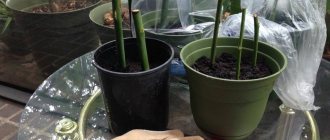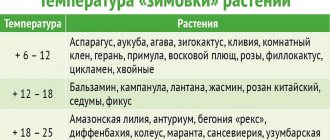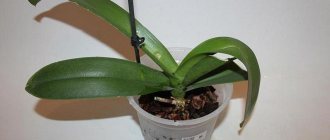To increase the number of rare varieties of roses in their flower beds, flower growers use cuttings. This is the best method for beginners; it is more reliable than grafting or propagation by layering.
Not all rose seedlings take root equally well. This article presents methods for successful rooting at home. They are affordable, simple and suitable not only for bush flowers, but also for those given as cut flowers.
Choosing roses for cuttings
To get a high percentage of rooting, the choice of planting material must be correct. Not all varieties take root equally well.
The easiest way to adapt when cutting is:
- Climbing, especially in varieties with small flowers.
- Polyanthas and hybrid-polyanthas reproduce well with green shoots in the summer, and partially woody shoots in the fall.
- Ground cover.
- Miniature ones take root easily even with the help of water.
- Floribunda varieties take root in half of the cases.
Difficult-to-root include:
- park;
- climbing large-flowered;
- scrubs;
- Most of them are hybrid teas.
Successful cuttings also depend on the color of the flower. The most suitable are burgundy and red, followed by pink and white. The yellow ones are the most difficult to root, they have the lowest survival rate of planting material and they die from infections more often than others.
Feeding
The rose blooms almost without interruption, and this takes a lot of energy from it. From spring to autumn, you need to apply fertilizer once a week - alternate mineral and organic. Complex fertilizers for indoor and flowering plants are also suitable; you can buy them at any flower shop.
Do not spray the rose often, this leads to fungal diseases. Once every two weeks, simply place the beauty under a cool shower - that’s all she needs for a good mood!
Harvesting cuttings
The cuttings should be medium in thickness and development. A 2-3 year old with a large center takes a long time to adapt and may begin to rot when moved to open ground. Young ones, usually red in color, are also discarded due to slow rooting. They do not have time to fully develop before the cold weather and freeze in winter.
There are usually 3 options for cuttings suitable for propagation:
- Stems are the most common planting material.
- Lignified - sufficiently matured and stunted annuals with a diameter of 0.4-0.5 cm. These are usually rooted in the spring.
- Semi-lignified - cuttings are carried out in the summer, the central part of the shoot is used.
If there are single varieties or bushes on the site, you can try cutting off shoots with one bud. But it should be remembered that they can grow into weak plants that are not prepared for wintering. The optimal option is 2-3 internodes, and for yellow roses it is better to leave 4 or more.
Here are the basic steps for preparing a cutting:
- The length of the shoot is at least 10-18 cm.
- The upper cut is smooth, made at a right angle, departing from the sheet to a height of 0.5-2 cm.
- The same distance from the kidney is measured from below, but you need to cut it at an angle of 45 degrees, with a sharp, disinfected knife.
- Remove thorns and lower leaf blades. Cut the top ones to half length. This will help retain moisture inside the seedling.
The prepared cuttings should be placed in water, to which you can add rooting preparations, for example, Heterauxin. For the same purpose, a honey solution is used: for 1 tbsp. take 1 tsp. honey and some crushed rose leaves. The liquid needs to be changed every 2 days and after 15-20 days a light compaction will appear on the lower cut - callus.
Next, the seedling can be planted in a flowerbed or wait for long roots to appear.
The disadvantage of this method is the lack of oxygen for proper development in the aquatic environment and, as a result, rotting.
In regions with cold winters, bushes grown by cuttings wait out the frosts in a dry basement with good ventilation, buried at an angle in the sand. Optimal storage temperature is +1…+3 °C and humidity 65-70%. The next season, young bushes remain in the open ground for the winter.
Rooting in the ground
This method is notable for the fact that the cutting is placed directly into a permanent pot for rooting. As in all other cases, there is no complete guarantee that the cutting will take root and take root. But this is one of the most popular methods of propagating tea roses at home. How to apply the method?
- According to all the rules stated above, cut the cuttings and process them.
- Pour nutritious and light soil into the pot, after roasting it in the oven (you can simply disinfect it with a manganese solution).
- Treat the lower part of the cutting with a solution that accelerates root formation.
- Place the cutting in the soil at a 45 degree angle. It needs to be deepened by 1/3 of the length.
- Water the planting well, cover it with a plastic bottle (without a lid or bottom), or cover it with a plastic bag - the greenhouse effect is important.
The greenhouse is removed after the rose takes root. You can simply check for the presence of roots: lightly pull the tip of the plant. If the cutting does not come out, then it already has roots. It is recommended to check no earlier than three weeks after planting.
Timing of cuttings of roses
The cutting period depends on the climate zone, as well as the variety of rose and the characteristics of the formation of its shoots. In the warm season, the preparation of planting material and its rooting can be done twice. This is mid-spring: in April-May in greenhouses. A prerequisite for certain imported roses, which are first grown in greenhouses and then grown in open ground.
The best time for propagation is in mid-summer: late June - early July, when the shoots are just beginning to wooden. This is usually the period before flowering, when the buds gain color. Cuttings used later have a lower rooting percentage.
Often, after autumn pruning, parts of the bushes remain that are a pity to throw away, and gardeners try to save them for subsequent spring planting. To prevent freezing of most of the shoots you need:
- Remove all leaf blades and thorns.
- Seal the sections with paraffin to prevent early germination.
- Store the cuttings in a cool place: basement, cellar or in the bottom compartment of the refrigerator.
Time and place for landing
The best time to plant roses in a country house or garden is spring or early summer. However, it is worth remembering that frosts are possible in spring, and frozen soil is not suitable for planting cuttings.
In this case, the month of March and part of April should not be chosen for planting due to unstable temperatures. But May and June, famous for their warmth, will be the best period for planting flowers. Planting material is prepared in advance.
To plant cuttings in the garden, choose a place with good soil and sufficient light so that after transplanting into the ground the roses begin to grow intensively.
It is recommended to plant in the morning, but not too early. It is worth waiting until the dew disappears, since roses do not like high humidity. If the day is not too hot, the landing can be done at noon.
Growing roses is also possible in a room at home. To do this, it is enough to carry out cuttings of cut branches from a donated fresh bouquet. This propagation of roses from a bouquet by cuttings is possible at any time of the year.
In autumn and winter, the rooted sections are then planted in a pot so that the rose can overwinter. And in the spring, the rose is transplanted from the pot into the garden.
How to properly prepare rose cuttings for cuttings, and the soil for planting plants both in the country and in apartments?
Cuttings of roses in summer
It is easier to carry out cuttings with summer shoots than with autumn shoots. They have enough time to adapt to the flowerbed chosen for them and prepare for wintering. Cuttings taken at a later date are less able to tolerate frost. The optimal time for cutting is June, and planting can be done until the end of July.
Cuttings are prepared in the manner described above, and they can be planted directly in open ground, without using greenhouses or greenhouses. However, it is necessary to choose an area without strong wind and bright sun.
The best option would be diffused light penetrating the flowerbed through the tree crowns. The soil should be loose and well permeable to moisture.
The cuttings are deepened into the soil at an angle and dug in. At first, a greenhouse made of plastic containers is needed on top; glass jars are also used. If a significant number of roses are planted, then a small greenhouse is made from wooden supports and polyethylene. The seedlings do not require special care; they only need timely watering.
In winter, young plants are covered with jars or a greenhouse, which can only be removed the next season - in the spring.
Rooting in water
This method is most suitable for propagating miniature and dwarf varieties of roses. Annual shoots that have either flowered or are just getting ready to do so are selected.
How to propagate a domestic rose at home? Water rooting is more productive in the presence of long daylight hours - this is summer or spring. Cut the cuttings, process as described above, and place in water. To prevent the liquid from blooming (which is detrimental to the plant), take an opaque container. This could be a dark glass flask, a mug, or a plastic glass.
Do not place the cutting in freshly collected tap water; it must be kept for a day. The liquid should be at room temperature. Next, the water will evaporate day after day, and this must be taken into account. Add settled water steadily, but do not change it under any circumstances.
Cuttings of roses in spring
For spring cuttings, it is necessary to make a greenhouse with pre-prepared soil: from turf and leaf soil, sand, ash and vermiculite in the proportion: 2: 2: 1: 0.5: 0.5. Length of the cut part of the plant: 10-15 cm.
When planting, it is necessary to powder the lower cut of the seedling with a growth stimulator and dig it 7-10 cm into the ground. If you dig deeper, this will slow down the formation of the root system. The sprouts should be 7-8 cm apart from each other.
The most important period is 15-20 days after planting. At this time, it is necessary to provide the cuttings with conditions for development:
- Watering is moderate; excess liquid will lead to rotting.
- High humidity level 80-90%. The leaf plates should be covered with droplets of water; for this you can use a spray bottle.
- Protection from direct sunlight. At high temperatures and hot air, ventilation is necessary in the morning and evening.
- A thorough inspection for the first signs of disease or decay.
After the root system has appeared, the rose can be transplanted into another small container 9-12 cm in size. To improve drainage properties, the top layer of the substrate 3-3.5 cm high should be sand.
Care all year round
In the spring, prune, this promotes the development of side shoots, the bush will become more luxuriant. Root and plant the cut cuttings. You need to trim old shoots, dried ones, as well as young and strong ones! Usually the shoots are pruned so that those remaining on the bush have at least three buds.
When it gets warm outside, put the rose on the balcony, this has a beneficial effect on its health. You don’t have to clean it up at night; we have already said that the plant easily tolerates temperature changes.
The first buds should be removed so that the rose blooms more abundantly. Next, do not forget to remove flowers that have faded.
Stop fertilizing in the fall; watering will also need to be reduced. Humidify the indoor air during the heating season, as dryness leads to the appearance of spider mites on the bushes.
We told you how to propagate roses from cuttings at home and the rules for caring for them. We hope this information will help you grow a beautiful and healthy plant!
Unusual ways to grow roses from cuttings
Various methods are used for rooting. Here are the most successful:
- in water;
- using potatoes;
- Trannoy method;
- burrito;
- in a plastic bag.
Planting rose cuttings in potatoes
The most popular way to root rose shoots is in potatoes. In a selected sunny area, protected from drafts, dig a hole 15 cm deep. To retain moisture in the soil, one third of its bottom should be filled with a layer of washed sand. Clean young tubers from their eyes and insert 20 cm cuttings prepared in advance into the holes. Place the potatoes in the ground at a distance of 15 cm from each other and cover 2/3 with soil. For the first 3-4 days, the plants must be covered with glass jars.
The advantage of this method is that the lower cut is constantly moistened and thanks to the potato, the rose receives nutrition and starch.
The main thing is not to forget about systematic watering and moisten the soil with sweet water every 5 days: 2 tsp per 200 ml. Sahara. After 14-15 days, begin hardening and remove the cover for a short time. After another 2 weeks, the jars can be removed completely.
Rooting cuttings in a bag
The effect of fog and high humidity can be easily achieved in another way, using a bag. It is necessary to put sphagnum moss in it, previously soaked in diluted aloe juice, in a ratio of 1:9 or a disinfected substrate. Next, inflate the polyethylene, tie it and hang it on the window. The roots will appear in 30-31 days. Afterwards, the cuttings need to be taken out and planted in pots.
Burrito Method
This method is actively used by flower growers in the USA and is becoming popular in Russia. This method is often used to root purchased roses. However, not everyone considers it effective.
The selection of cuttings occurs during spring pruning, and many shoots that are usually sent to the trash can become beautiful rose bushes in the future. Their main difference from other selected planting material is thickness; they should not be thin. A pencil or finger can be a guide; the length should be at least 15-20 cm. It is important in the early stages of preparation to discard all parts of the plant with defects or darkening. This is a sign of mold and one affected cutting can infect all the others.
The lower cut of the prepared shoots is sprinkled with Kornevin or treated with Epin, and wrapped in moistened newspaper and placed in a bag. You can use fabric instead of paper. Place in a cool place with a temperature of +15...+18 °C for 2 weeks, during which small roots should form.
Once every 7 days, the bundle must be opened and inspected for the presence of fungus or blackened seedlings, which are also removed. When the paper dries out, you can slightly moisten it. After callus has formed, the roses are moved to a flowerbed for further growth and adaptation.
Trannoy method
This method involves selecting cuttings after the main wave of flowering. Experts suggest choosing plant shoots with fading rosettes and two leaf blades and cutting off the middle part with swollen buds until leaves appear from them. The main thing is not to miss this moment. The length of the cutting is at least 20 cm. All greenery must be torn off, leaving only a couple at the top.
Plant several pieces at a time in a hole at 45 degrees in the selected area. On top of each group you need to place a 5-liter plastic jar with the neck cut off. This is reliable protection for planting material until frost, despite the appearance of leaves and new shoots. To supply the roots with oxygen, the soil around the plantings must be loosened. It is important not to forget about watering.
Burrito method
There is no 100% guarantee that roots will appear when using this method. But the Burrito method is so simple that you can still try it.
How to propagate indoor roses at home? Try following the following instructions:
- Cut the selected shoots of the bush into cuttings. Moisten the lower parts of the cuttings with “Kornevine” or a similar preparation.
- Take newspaper, wet it well, and wrap the bottom of the cuttings.
- Next, the package needs to be put away in a warm but dark place.
According to reviews from people who have already tried this method, roots can appear within two weeks. Be sure to keep the newspaper bundle moist, otherwise the cutting will simply dry out.











